



Suggested citation: TMC and CEEW. 2024. Heat Action Plan for Thane City 2024. Thane: Thane Municipal Corporation, Thane; and Council on Energy, Environment and Water (CEEW).
Current trends and future climate projections for India indicate an escalation in the intensity, frequency, and duration of heat waves. Coastal cities like Thane face additional risks, with compounding factors such as humidity and urban heat islands. The interaction of these elements can elevate felt temperatures by 3-4 degrees Celsius.
To prepare for and mitigate the heat risks in Thane city, the Council on Energy, Environment and Water (CEEW) and Thane Municipal Corporation have collaborated to proactively develop the city's inaugural heat action plan.
Dedicated to achieving zero mortalities from extreme heat, minimising heat-related illnesses and stress, and reducing economic impacts, the Thane Heat Action Plan adopts a ‘when, where, who and how’ (3WH) framework for heat action strategies, aligning with the 2019 NDMA National Guidelines for Preparation of Action Plan: Prevention and Management of Heat Wave (NDMA 2019). It undertakes granular assessment of heat risks by considering historical patterns and future projections encompassing felt heat (temperature + humidity), urban heat island effects, warm nights, and socioeconomic factors at a granular ward (Prabhag Samitee) level.
In 2023, a global temperature record was set, marking it as the hottest year on record. Such intense global warming will breach the critical 1.5°C threshold within the next five years (World Meteorological Organization 2023). The consequences of this heightened warming are already evident in vulnerable and developing countries such as India. In February 2023, the India Meteorological Department (IMD) reported the hottest February since 1901. Subsequently, in May 2023, 10 Indian states faced a prolonged heat wave lasting 2–3 weeks (IMD 2023). Moreover, in its 2024 summer season forecast, IMD has predicted a high probability of above-normal maximum as well as minimum temperatures leading to longer duration of heatwaves in majority parts of India (IMD 2024).
Climatic projections for India indicate that heat extremes are likely to intensify, occur more frequently, last longer, and impact wider geographical areas not previously impacted. Other factors, such as humidity and urban heat islands, particularly in cities, will further exacerbate and compound the risks associated with these extremes. With such record-breaking heat waves already being witnessed nationwide, there is an urgent need to develop and implement heat risk mitigation and adaptation strategies to reduce the impacts of heat waves across various geographical scales.
Currently, India has more than 4,800 urban local bodies (ULBs), representing approximately 35 per cent of the country’s population (Ministry of Social Justice and Empowerment 2023). Urban areas face multifaceted challenges associated with both slow-onset events, such as heat waves, and rapid onset events, such as extreme precipitation-induced urban flooding. Cities are also home to a significant number of vulnerable populations, such as senior citizens, children, and individuals with comorbidities and chronic health conditions. This escalates the risks associated with heat stress. Given this context, cities in India must develop comprehensive heat action plans as recommended by the National Disaster Management Authority (NDMA) in their 2019 guidelines, focusing on localised heat risk mapping and developing effective mitigation, preparedness, and response mechanisms.
Coastal cities in India face an additional challenge in the form of compounded risks due to humidity, which can contribute up to an additional 3–4°C when the dry temperature exceeds 30°C and relative humidity surpasses 60 per cent. Consequently, heat action plans for coastal Indian cities such as Thane must factor in the compounded effects of relative humidity. Additionally, the often-overlooked impact of warm nights on health necessitates urgent attention as it significantly contributes to widespread cases of heat strokes and related illnesses as warmer nights do not allow for recovering from daytime heat waves.
Thane City’s administration attempted to address these challenges by developing a city-level heat action plan, offering insights into heat risks considering historical trends and projections of dry temperature extremes, humidity, warm nights, and socioeconomic factors at a detailed ward/ Prabhag Samitee level (Figure ES1). The primary objective was to mitigate the impact of heat stress on human health and establish effective pathways for preparedness and response mechanisms.
Figure ES1 Uniqueness of the Thane City Heat Action Plan
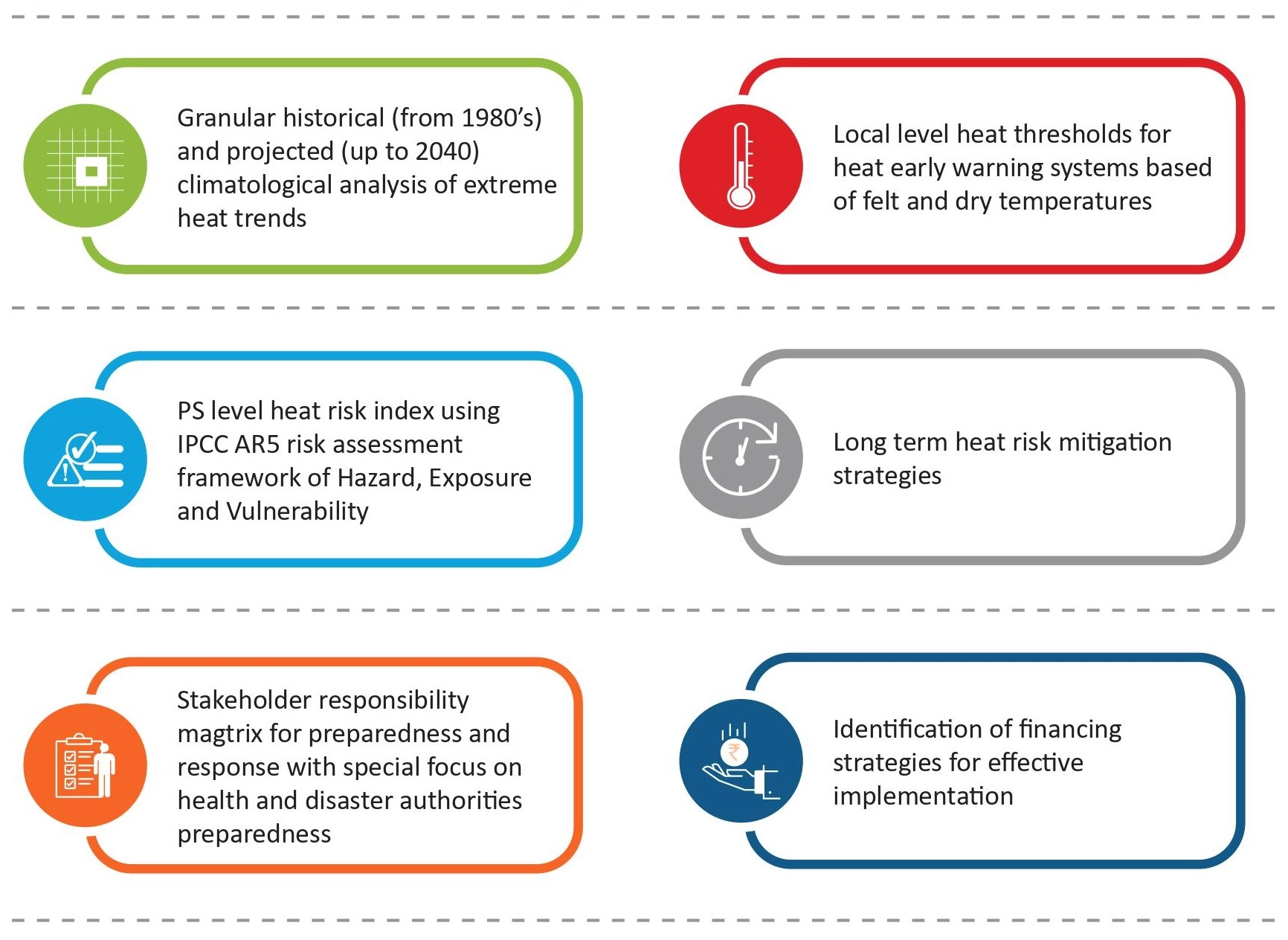
Source: Authors’ compilation
Maharashtra’s HAP already recognises eastern Maharashtra as a significant heat wave hotspot. However, Thane, situated near the coast, faces additional challenges due to the combination of temperature and humidity. Although not currently labelled as a heat wave hotspot, climatological projections indicate a substantial threefold increase in the frequency of extreme hot days from 2024 to 2040, compared to the period between 1982 and 2024. Consequently, the frequency of warm nights is anticipated to surge nearly fourfold during the same timeframe. Hence, this plan prioritises the mitigation of long-term heat risk and aims to cultivate a culture of preparedness and response to heat waves.
Dedicated to achieving zero mortalities from extreme heat, minimising heat-related illnesses and stress, and reducing economic impacts, the Thane Heat Action Plan adopts a ‘when, where, who and how’ (3WH) framework for heat action strategies, aligning with the 2019 NDMA National Guidelines for Preparation of Action Plan: Prevention and Management of Heat Wave (NDMA 2019).
When to take action: This stage involves establishing city-specific heat thresholds for Thane by analysing bio-meteorological indices, particularly the heat index. Using a long-term (1982–2022) percentile approach, these thresholds map the felt heat based on observed extremes. Though the IMD provides general regional criteria for all coastal areas based on dry maximum temperature for heat wave forecast and declaration, local thresholds for Thane were calculated by considering climatic variables namely maximum temperature and relative humidity. This is crucial for addressing heat stress in a coastal region considering acclimatisation levels in order to enhance the efficiency of heat early warnings. Additionally, similar thresholds based on dry temperature have also been developed, and the plan outlines mechanisms for issuing alerts and early warnings to relevant departments and the population.
Figure ES2 The felt temperature thresholds for colour-coded alerts based on the heat index that indicates the impact of humidity in addition to dry temperature

Source: Authors’ analysis
Where to take action: Following the IPCC’s risk assessment framework as per its 5th Assessment Report (AR) of 2014, the Thane HAP provides the ranking of all 9 wards in Thane City based on the quantified heat risk. Hazard indicators were quantified using the IMDAA reanalysis climate data (1982–2022) and land surface temperatures from satellites, while a combination of satellite-based indices and socioeconomic data collated by various departments of Thane Municipal Corporation was used for exposure and vulnerability mapping.
An analysis of the heat index, combining temperature and relative humidity (referred to as felt temperature), reveals a substantial increase in both felt and dry maximum temperatures over the last 40 years (1982–2022) during Thane’s summer months. The average difference between felt and dry temperatures, indicating rising humidity-related temperatures, has slightly increased in recent years. For instance, in 2022, the average summer maximum felt temperatures were nearly 3o C higher than dry temperatures, emphasising the impact of increased heat stress due to the added humidity factor (Figure ES3).
Figure ES3 The difference between dry temperature and felt temperature (dry temperature + relative humidity) has increased by up to 3°C in Thane City over the past 40 years
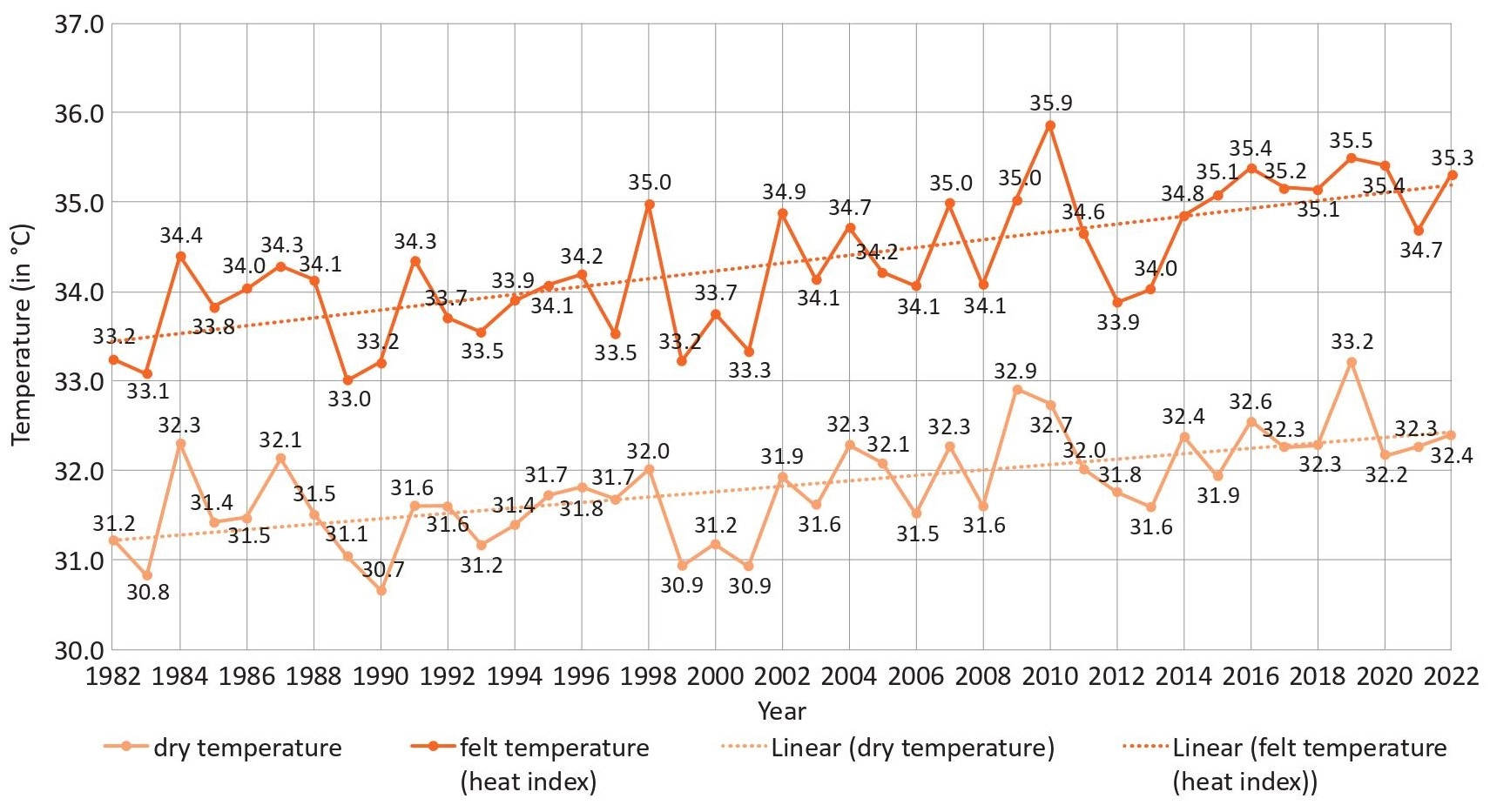
Source: Authors’ compilation
As per Thane City’s heat risk index seen in Figure ES4, Wagle and Mumbra Prabhag Samitees are under the highest risk, followed by Kalwa and Lokmanya Savarkar Nagar Prabhag Samitees, which fall in the moderate risk category. They are followed by Diva, Naupada, and Uthalsar, showing low risk and Vartak Nagar and Majiwada-manpada having very low risk.
Who will and how to take action: The responsibilities matrix, outlining mitigation, preparedness, and response strategies, distinctly delineates the roles of relevant departments, the supportive role of the District Disaster Management Authority (DDMA), State Disaster Management Authority (SDMA) and other stakeholders for ensuring effective coordination during plan implementation (See chapters 6 and 7 of this HAP). Thane Municipal Corporation has instituted a Heat Wave Task Force Committee (Refer to annexure 4) that will monitor the execution of the plan and conduct a review after summer season. Documenting lessons learned from this plan will enhance future plan design and implementation. A monitoring and evaluation framework (See chapter 10) tracks and reports progress on each action in the heat action plan. Financial mechanisms for short-term, medium-term, and long-term actions are also identified by each department.
The plan additionally integrates the formats provided by Ministry of Health and Family Welfare (MoHFW) for recording health-related mortalities and illnesses. Information, education, and communication (IEC) strategies are identified to enhance outreach and awareness.
Figure ES4 Heat risk index for Thane City across different Prabhag Samitees as of 2024
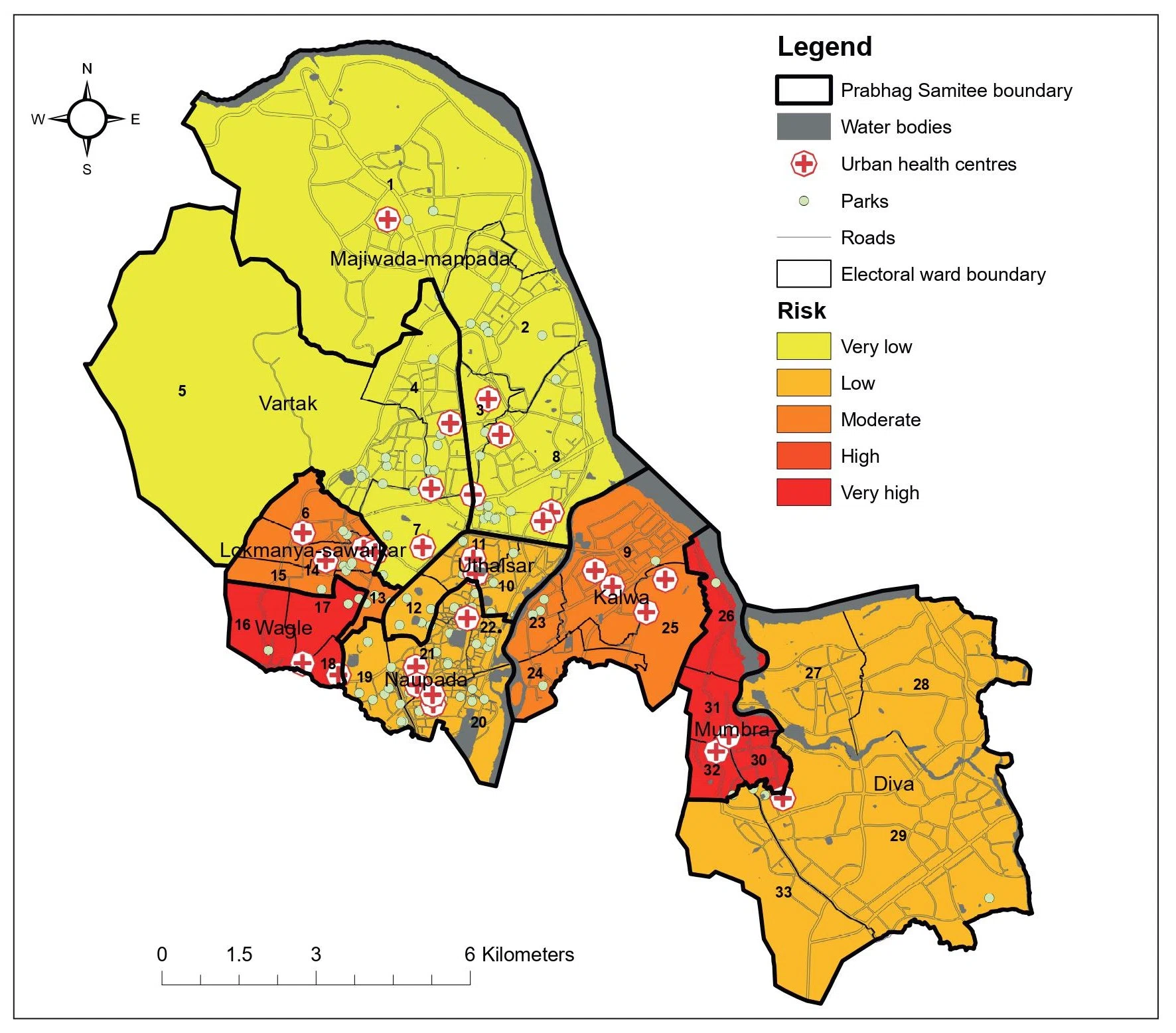
Source: Authors’ analysis
The temperature is increasing in India due to a combination of climate variability and human-induced factors. Greenhouse gas emissions, deforestation and industrial activities cause global warming, which leads to rising temperatures. India also observes a rapid urbanisation trend, which means it goes through large scale changes in land use. This, in combination with the humidity factor, amplifies the urban heat island effect which leads to even higher temperatures in densely populated urban areas.
In February 2023, the India Meteorological Department (IMD) reported the hottest February since 1901. Subsequently, in May 2023, 10 Indian states endured a prolonged heat wave lasting 2-3 weeks. Such extreme events lead to impacts such as heat-related deaths, challenging working conditions, and a wider spread of vector-borne diseases, especially on vulnerable populations such as those living in slums. It also impacts other critical sectors such as agriculture. For instance, the recent 2022 heatwave, one of the longest-lasting, led to wheat yield reductions of 15-25 per cent in Indo-Gangetic plains states.
Climatic projections suggest that heat extremes in India will intensify, become more frequent, endure longer, and impact broader geographical areas. However, it is possible to prevent a heatwave from escalating into a disaster with strategic and effective planning. Therefore, we need to formulate risk-driven and context specific heat risk mitigation and adaptation strategies in the form of a heat action plan to reduce the impacts of heatwaves.
Thane city's administration attempts to address heat stress in the coastal city by developing a city-level heat action plan, offering insights into heat risks considering historical trends and projections of dry temperature extremes, humidity, warm nights, and socioeconomic factors at a detailed ward/Prabhag Samitee level. The primary objective is to mitigate the impact of heat stress on human health and establish effective pathways for preparedness and response mechanisms.
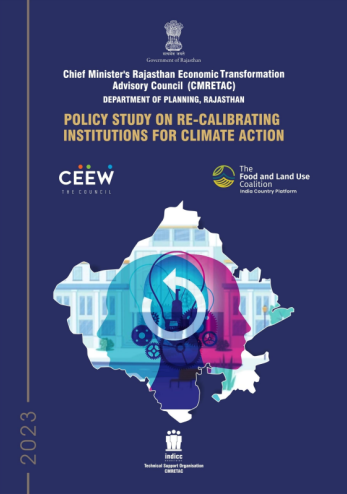
Policy Study on Re-calibrating Institutions for Climate Action
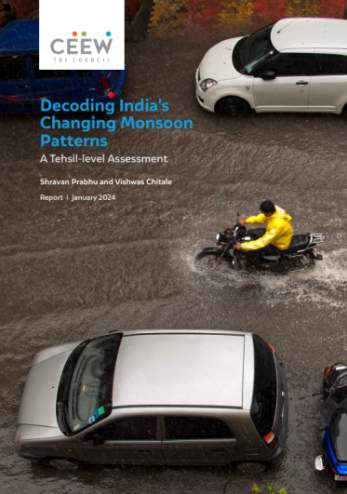
Decoding India’s Changing Monsoon Patterns
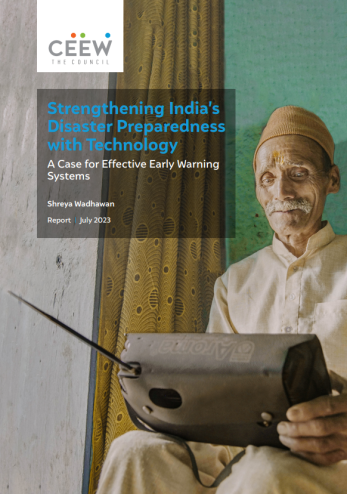
Strengthening India’s Disaster Preparedness with Technology
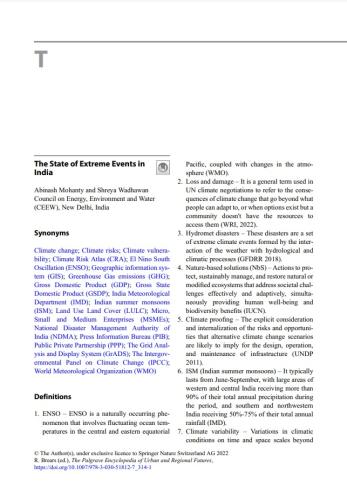
The State of Extreme Events in India